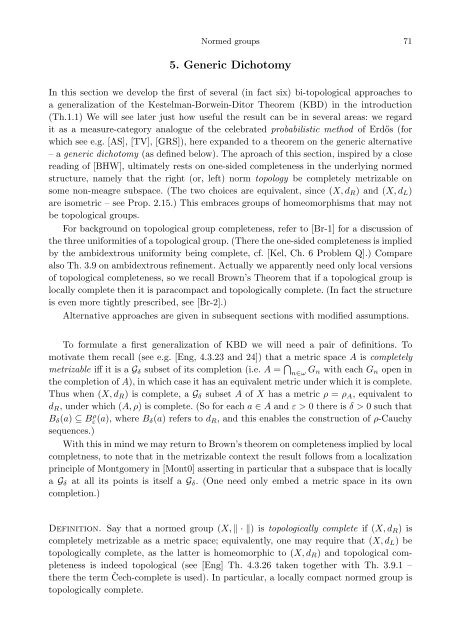Normed versus topological groups: Dichotomy and duality
Normed versus topological groups: Dichotomy and duality
Normed versus topological groups: Dichotomy and duality
You also want an ePaper? Increase the reach of your titles
YUMPU automatically turns print PDFs into web optimized ePapers that Google loves.
<strong>Normed</strong> <strong>groups</strong> 715. Generic <strong>Dichotomy</strong>In this section we develop the first of several (in fact six) bi-<strong>topological</strong> approaches toa generalization of the Kestelman-Borwein-Ditor Theorem (KBD) in the introduction(Th.1.1) We will see later just how useful the result can be in several areas: we regardit as a measure-category analogue of the celebrated probabilistic method of Erdős (forwhich see e.g. [AS], [TV], [GRS]), here exp<strong>and</strong>ed to a theorem on the generic alternative– a generic dichotomy (as defined below). The aproach of this section, inspired by a closereading of [BHW], ultimately rests on one-sided completeness in the underlying normedstructure, namely that the right (or, left) norm topology be completely metrizable onsome non-meagre subspace. (The two choices are equivalent, since (X, d R ) <strong>and</strong> (X, d L )are isometric – see Prop. 2.15.) This embraces <strong>groups</strong> of homeomorphisms that may notbe <strong>topological</strong> <strong>groups</strong>.For background on <strong>topological</strong> group completeness, refer to [Br-1] for a discussion ofthe three uniformities of a <strong>topological</strong> group. (There the one-sided completeness is impliedby the ambidextrous uniformity being complete, cf. [Kel, Ch. 6 Problem Q].) Comparealso Th. 3.9 on ambidextrous refinement. Actually we apparently need only local versionsof <strong>topological</strong> completeness, so we recall Brown’s Theorem that if a <strong>topological</strong> group islocally complete then it is paracompact <strong>and</strong> <strong>topological</strong>ly complete. (In fact the structureis even more tightly prescribed, see [Br-2].)Alternative approaches are given in subsequent sections with modified assumptions.To formulate a first generalization of KBD we will need a pair of definitions. Tomotivate them recall (see e.g. [Eng, 4.3.23 <strong>and</strong> 24]) that a metric space A is completelymetrizable iff it is a G δ subset of its completion (i.e. A = ⋂ n∈ω G n with each G n open inthe completion of A), in which case it has an equivalent metric under which it is complete.Thus when (X, d R ) is complete, a G δ subset A of X has a metric ρ = ρ A , equivalent tod R , under which (A, ρ) is complete. (So for each a ∈ A <strong>and</strong> ε > 0 there is δ > 0 such thatB δ (a) ⊆ Bε ρ (a), where B δ (a) refers to d R , <strong>and</strong> this enables the construction of ρ-Cauchysequences.)With this in mind we may return to Brown’s theorem on completeness implied by localcompletness, to note that in the metrizable context the result follows from a localizationprinciple of Montgomery in [Mont0] asserting in particular that a subspace that is locallya G δ at all its points is itself a G δ . (One need only embed a metric space in its owncompletion.)Definition. Say that a normed group (X, ‖ · ‖) is <strong>topological</strong>ly complete if (X, d R ) iscompletely metrizable as a metric space; equivalently, one may require that (X, d L ) be<strong>topological</strong>ly complete, as the latter is homeomorphic to (X, d R ) <strong>and</strong> <strong>topological</strong> completenessis indeed <strong>topological</strong> (see [Eng] Th. 4.3.26 taken together with Th. 3.9.1 –there the term Čech-complete is used). In particular, a locally compact normed group is<strong>topological</strong>ly complete.
















